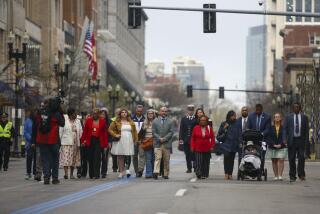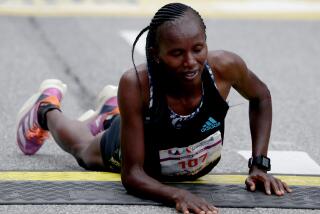For Lebow, Life Itself Is a Marathon
The night he was told he had an inoperable brain tumor and had three to six months to live, Fred Lebow couldn’t sleep. The news was dreadful, but Lebow wouldn’t even consider the possibility of dying. His mind wandered instead to running a marathon, his marathon, the New York City Marathon.
Lebow had run 68 marathons, but never the one he made famous. So that night in late February 1990 at New York’s Mount Sinai Medical Center, he began to imagine running the streets of New York.
“When I finally fell asleep, I felt fantastic,” he said. “I felt great. I haven’t shed a tear since.”
Just as Lebow anticipated, he didn’t die in three to six months. Now, 2 1-2 years later, with his cancer in remission, he has put in hundreds of miles -- including five half-marathons since March -- to run in Sunday’s 23rd annual New York City Marathon.
“I feel very strong,” Lebow, 60, said the other day over the phone. “If I can’t run it, I’ll walk it.”
This is a most unusual story, and not simply because of Lebow. By his side, running every step of the five-borough race with him, will be Grete Waitz, the 39-year-old Norwegian legend who has been the women’s winner of this race nine times.
After hearing of Lebow’s interest in running the race, she chimed in, saying she would like to escort him along the route. He said he’d like that.
Instead of running her usual 2-hour 27-minute or 2:28 pace, she will have to slow way, way down and run his pace, which will be about five hours. (His fastest time is 3:30, but that was 20 years ago.)
“The past four weeks in my training runs, I’ve been running nine-minute miles, and Fred and I will even be going slower than that,” Waitz said Friday. “I’m trying to get used to being on my feet for five hours or so. I’m not usually out on the course that long.”
“We’ll be halfway through when she normally finishes,” Lebow said. “But she said that was okay. She’ll be a guard for me. She’ll protect me.”
Lebow, who is planning to run with his thumbs up to acknowledge the anticipated reception of the crowd along the route, is dedicating his race to raise money for Sloan-Kettering Cancer Center. In a letter to prospective donors, Waitz wrote, “What can I say about a man who has done more for the sport of running than anyone I can think of? ... Fred has done so much for us all -- now, let’s do something for him.”
“I’m a little nervous,” Lebow said. “Wouldn’t you be if you ran with a person like Grete Waitz?”
Waitz wants to make sure Lebow doesn’t get too carried away by the moment. She will suggest they walk for two minutes after each water station -- located every three miles -- so Lebow doesn’t get too tired.
“Running-wise, he’s prepared, but I worry that he’s trying to do too much in organizing the marathon and isn’t relaxing enough before the race. But that’s Fred.”
Those who are familiar with the pageantry of the New York City Marathon know all about Lebow, the masterful promoter with the beard, bicycle cap and thick Romanian accent who rides the course in the lead Mercedes, shouting for people to come out of their homes and offices to cheer on his runners.
He turned this race from a quaint little jog around Central Park into a citywide event with big-name runners, 25,000 total entrants and thousands of dollars in prize money. Every top marathon runner in the world knows New York, thanks to Lebow.
Now, Lebow will become its most famous runner.
But first, there was the cancer. His most torturous time came in the spring of 1990, when he underwent two biopsies on the tumor in his head and developed a blood clot below his knee. He spent eight weeks in the hospital, undergoing chemotherapy and radiation.
In the summer of 1990, he was told his cancer was gone. Every six months, doctors give him a magnetic resonance imaging test to make sure.
“It’s not a miracle,” Lebow said. “Obviously the doctors were incorrect. However, if I didn’t take care of myself physically and mentally, I wouldn’t be here today. After my first biopsy, as I was lying there in my hospital bed, I immediately thought about staying fit. So I began doing exercises with my finger and arm -- anything I could do.”
Training for this marathon hasn’t been easy.
“A certain amount of running is on memory,” he said. “I put my legs down and my memory takes over.”
The day he was speaking on the phone, he said he didn’t feel like running, so he didn’t try. “It’s my first day I didn’t run,” he said. “I usually take off one day, so this is it. Some days, I can feel bad in the morning and then I go for a run and my body feels good.”
One of the side effects of the chemotherapy and radiation has been extremely positive: Knee pain Lebow had experienced for five years since undergoing arthroscopic surgery has stopped, apparently for good.
Certainly one of his strongest motivations for running 26 miles 385 yards is what it will mean to other cancer patients. Lebow has received hundreds of letters and phone calls and said he has answered them all.
“It’s important to show you can beat cancer,” he said, “and I think my running can do that.”
But it’s more than that for Lebow.
“Running in your own marathon is what any athlete would want to do,” Lebow said.
A handful of years ago, two days after the New York City Marathon was run, Lebow received a phone call telling him someone still was on the course. The report said it was a Vietnam veteran with no legs who was “running” on his hands.
“I immediately went out and looked for him, but couldn’t find him anywhere,” Lebow said. “Finally, I did find him, in the Bronx, about 17 miles into the race.”
Lebow said it took that man four days to finish.
“I came out every day to see how he was doing,” he said. “I put him up in a hotel at night. It was really remarkable.”
More to Read
Sign up for Essential California
The most important California stories and recommendations in your inbox every morning.
You may occasionally receive promotional content from the Los Angeles Times.










